

- #MUTATION RED RUMPED PARROT FULL#
- #MUTATION RED RUMPED PARROT PLUS#
- #MUTATION RED RUMPED PARROT SERIES#
Marble birds can be a little tricky to sex - that eumelanin reduction can bring out a lot of blue coloration in females that can give the appearance of them possibly being male. The degree and quality of the marble pattern often affects the price - with well marbled birds ranging anywhere from $300-$600. It's not consistent, though, meaning one bird may have a 30% reduction in eumelanin while the next may have a 60% reduction! This means that not all marble birds look alike, and some have very beautiful a striking marble patterns, while others simply appear to have a color washed look to them. The left-over/concentration of eumelanin in the outer edges of the feathers is what creates the 'edged' or marbled appearance. The reason the edging occurs is because the reduction of the eumelanin is happening mainly in the center of the feather. Marble is an autosomal recessive gene that was previously referred to as "Pastel." Marble is a eumelanin mutation that results in the appearance of 'edging' on the covert and primary feathers. (Note: Fallow and Ino babies will also have clear toenails even if they are not pied). A little trick to identify pied babies is they often have clear toenails. Pied birds produce both pied and non-pied offspring. You can see examples of this in some of the wing photos below. The difference will be in the overall body color. For any pied birds, pure pied primary flight feathers will have a white rachis, similar to American birds. In Turquoise pied birds, any pied feathers in the forehead will always be yellow due to Turquoise birds having Turquoise Foreheads. In a turquoise bird, since it's an intermediate color, the bird can have both yellow AND white feathers. In a blue bird, the pied feathers will be white (since the bird cannot produce lutein, the pigment responsible for yellow color). In a green bird, pied feathers will be yellow. Meaning a single copy present will produce pied feathers - the degree to which is highly variable and not all that predictable. Whereas many of the parrotlet mutations are recessive genes that require a bird to possess both copies for them to phenotypically (visually) express the color, the Pied gene is a single acting gene on the body feathers of the bird. For instance - Green is the dominant form, and introducing two copies of the recessive American gene produces a visually Yellow bird. Pied is a dominant trait that can be a little tricky to grasp because there is no 'recessive' counterpart. Male red-rumped parrots are much more colourful than the females. They live in pairs or small flocks and can often be seen feeding in city parks or on grass verges along roadsides. Consistency would make sense, but that's not what the bird world is all about. These beautiful grass parrots are found in New South Wales, Victoria, southern Queensland and eastern parts of South Australia.
#MUTATION RED RUMPED PARROT PLUS#
Plus - American Yellow and American White describe a phenotype, and if you're going to be proper, it should be American Green (the American gene present on a green-bodied bird) and American Blue (the American gene present on a blue-bodied bird) - we see this already with American Turquoise (the American gene present on a turquoise-bodied bird). It describes nothing about how the gene behaves and purely identifies its location of discovery. So you will often see Yellow Parrotlets advertised as "American Yellows." But, if you ask me, this is a bit silly. Truly - the gene itself is referred to as "American" because it was discovered in America. The male (above) has a red back/rump, yellow belly and some turquoise/blue in its green and grey plumage.
#MUTATION RED RUMPED PARROT SERIES#
It's interesting to note as well that in pied birds, pure pied areas of the primary feathers in Pied series birds will also have a white rachis matching up with the pied sections of the feather. Red-rumped Parrot Psephotus haematonotus The Red-rumped Parrot, also called the Red-backed Parrot, is one of Australia's grass parrots/parakeets, from southeastern Australia. If you have a Marble bird that is also American, the rachis will be white right up to about 1/2 inch before the end of the feather which will be characteristically gray in color as seen in all Marble birds.

In American birds (where no Ino is inherited) you will *always* see a white rachis in the primary flight feathers.

It's interesting to note that the structural blue pigment is only affected in the body color feathers and NOT the sexually-dimorphic areas of the bird, suggesting the pathway isn't completely incapacitated but that in some metabolic pathways it has at least been disrupted. There are examples of breeding expectations, housing, feeding and management.The American mutation is a recessive gene affecting the wild-type bird where structural blue color is interrupted, leaving a dark eyed bird that is visually yellow in color if the base color is green.
#MUTATION RED RUMPED PARROT FULL#
This title features over 160 full colour images of mutations in the Neophema and Psephotus Grass Parrot group.


 0 kommentar(er)
0 kommentar(er)
